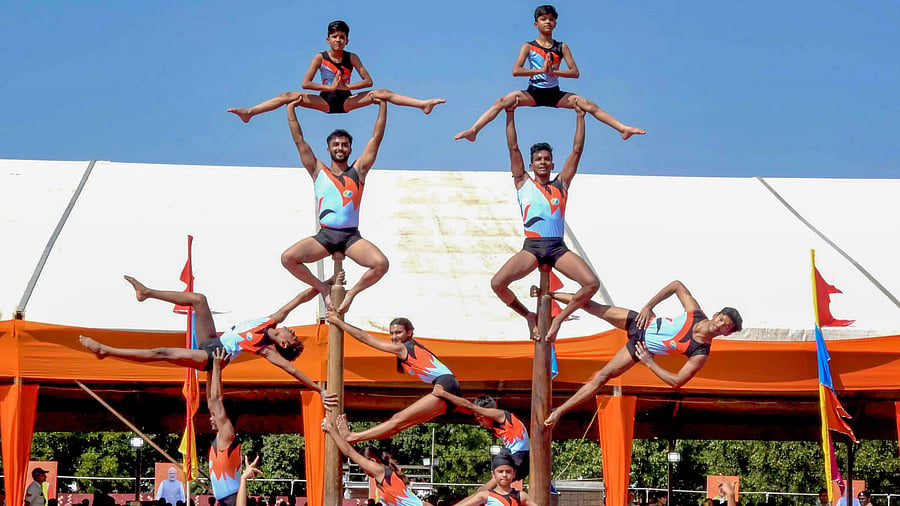
Children exhibit their Mallakhamb skills. Representative purpose
Credit: PTI File Photo
India’s diversity is often celebrated through its cuisine, languages, and traditions. But hidden in its villages, festivals, and folklore are treasures usually overlooked: India’s indigenous sports, gems of culture that have evolved over centuries. They are not only physical pursuits but also powerful expressions of identity, community, and continuity.
Some of these sports are so primal and instinctive that their origins are impossible to trace. Wrestling, archery, spear-throwing, stone-lifting, and boat racing evolved not just as recreation but as skills essential to survival for hunters, warriors, and farmers alike.
References to games in India date back to ancient texts, the Indus Valley Civilisation, and the Mughal era. It later clashed with colonial imports like cricket, tennis, and football. Throughout history, dominant powers have used sport to train troops, maintain readiness, and subtly assert control, often engaging with local communities under the guise of friendly competition. The 2001 film Lagaan captured this power dynamic with dramatic flair.
Encouragingly, the recently announced National Sports Policy 2025 acknowledges this lost legacy. Under the pillar of Sports for Social Development, the policy commits to “revitalising and promoting indigenous and traditional games.” In a polarised world, reviving these sports can build community and preserve fading knowledge systems.
Kabaddi and kho-kho, two of the better-known traditional games, both require sharp reflexes, agility, and strategy. They are now internationally recognised and have their own professional leagues. Others, like Mallakhamb, a stunning blend of yoga and gymnastics performed on a vertical pole or rope, have featured in Khelo India events.
There are numerous weapon-based martial art forms. Kalaripayattu, popular in Kerala and dating back to the third century BCE, was practiced along with Atya-patya, a variation of tag, possibly originating as an agrarian skill to drive away predators from their fields. Gatka, a traditional Sikh martial art using sticks and swords, is not only physically demanding but also spiritually rooted and regularly showcased at festivals. Manipur’s Thang-Ta (Huyen Langlon) involves swords, shields, and spears. Silambam, from Tamil Nadu, is an elegant bamboo staff art form with Dravidian roots. Mushti Yuddha, an unarmed combat sport from Varanasi, bears similarity to today’s kickboxing.
Across India, we can see local variants of martial arts, built on the foundations of self-defence, physical conditioning, grappling, striking, and weapon use. These practices are beautifully interwoven with yoga, ayurveda, dance, and spiritual philosophy, offering not only fitness and skill but also holistic mind-body discipline.
Other physical forms include Malla-Yuddha, the oldest wrestling tradition, with a mention in the Mahabharata and Ramayana. Khusti/Pehlwani continues to thrive in akharas (training centres). Vajra-Mushti, a brutal variant where a knuckle-duster-like weapon is used, dates back to the Mauryan Dynasty. Earlier versions of these combat sports resulted in fatal outcomes. Now, of course, modern adaptations comply with international safety protocols, including protective gear and weight classes. These wrestling traditions are still vibrant in states like Haryana and Maharashtra, where they have produced internationally renowned athletes.
Board games like Chaturanga, a precursor of chess, originated in India during the Gupta Dynasty. Vaikunta Pali/Paramapada/Moksha Patnam (snakes and ladders) began as a morality-based game. Other games popular among the masses include Pachisi (Ludo), goli gundu (marbles), and Carrom. Interestingly, Pachisi, the
ancient ‘game of dice,’ played a pivotal
role in the high-stakes drama of the epic, Mahabharata.
In Karnataka, even now, we can see Gilli Danda (Chinni Dandu), played with a peg (gilli) and stick (danda), a popular gully sport. Buguri (spinning top), lagoori (seven stones), and other traditional games continue to survive. Animal-based sports like Kambala (buffalo racing) are losing their appeal as awareness around animal welfare grows.
The beauty of these games lies in their simplicity. Most don’t require sophisticated equipment, just sticks, stones, open patches of land, or handmade tools. Large infrastructure is not required. They are accessible, inclusive, and inherently sustainable.
Annual local festivals/melas often feature traditional sports alongside art, music, and culinary delights. These events help preserve fading techniques and foster intergenerational bonding. The Kodava Hockey Festival in Karnataka is one fine example, where families across Coorg reunite over hockey, celebration, and camaraderie. In Kerala, the Vallam Kali (boat racing) during Onam continues to stir deep community pride and promote social cohesion.
The role of sport in nation-building, cultural diplomacy, and soft power must not be overlooked, especially as global audiences increasingly value authenticity and tradition. That said, India is an amalgamation of cultures, languages, and geographies, with sport a state subject. Each state must champion its heritage through sports tourism and grassroots promotion. Many indigenous sports are hyperlocal and understood only within their communities. For a sport to reach the masses, it needs to be ‘media-friendly,’ i.e., easy to follow and visually engaging on screen. Football, for instance, is simple: two teams, two goalposts, and one ball.
By contrast, a martial art like Kalaripayattu might be fast-paced, complex
to learn, and difficult to capture on screen. Yet, just as chess and kabaddi, once
considered unmarketable, have been reimagined through savvy broadcasting and creative formats, there’s no reason others can’t follow. Where there is public interest, innovative market pathways can be paved.
However, we must resist the urge to evaluate these sports purely through a commercial lens. Their deeper value lies in empowerment, cultural continuity, and the joy of collective experience.
India’s indigenous sports add vibrancy to our nation’s rich tapestry; let’s continue to honour the games that shaped us, even as we pursue global sporting ambitions.
(The writer is a sports analyst and head of the Policy School, Takshashila Institution)